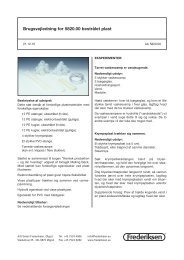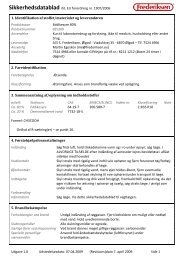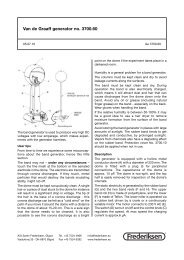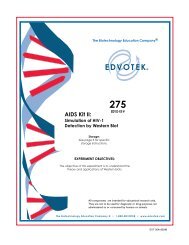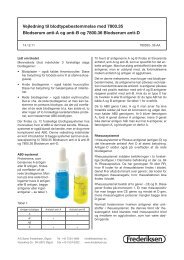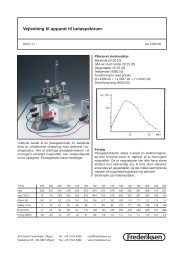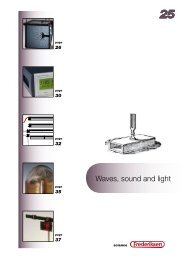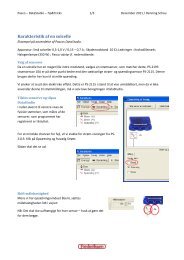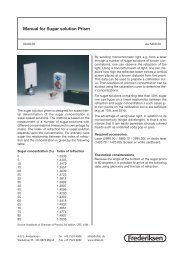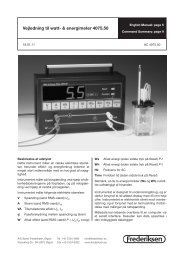255 - Frederiksen
255 - Frederiksen
255 - Frederiksen
- No tags were found...
Create successful ePaper yourself
Turn your PDF publications into a flip-book with our unique Google optimized e-Paper software.
The Biotechnology Education Company ®RevisedandUpdatedEDVO-Kit #<strong>255</strong>Purification & SizeDeterminationof Green (gfp) & Blue (bfp)Fluorescent ProteinsStorage: See Page 3 forspecific storage instructionsExperiment Objective:Students will learn to partially purify theGreen (gfp) and Blue (bfp) fluorescent proteins.In an optional activity, the molecular weightsof the proteins will be determined.All components are intended for educational research only. They are not to be used for diagnosticor drug purposes, nor administered to or consumed by humans or animals.EDVOTEK, Inc. • 1-800-EDVOTEK • www.edvotek.comEVT 005097K
EDVO-Kit #<strong>255</strong> xxxPurification & Size Determination of gfp & bfpTable of ContentsPageExperiment Components 3Experiment Requirements 3Background Information 5Experiment ProceduresExperiment Overview 7Packing and Equilibrating the Column 8Partial Purification of gfp and bfp Proteins 9Sample Preparation for Denaturing SDS-gel Electrophoresis 10Electrophoresis of Proteins 11Staining the Gel 14Determination of Molecular Weights 16Study Questions 18Instructor's Guidelines 19Pre-Lab Preparations 20Electrophoresis Hints and Help 22Idealized Schematic of Results 23Study Questions and Answers 24Material Safety Data Sheets 25Protein Plus, FluoroGreen and FluoroBlue are trademarks of EDVOTEK, Inc.InstaStain, EDVOTEK, and The Biotechnology Education Company are registered trademarksof EDVOTEK, Inc.EVT 005077KEDVOTEK, The Biotechnology Education Company, and InstaStain are registeredtrademarks of EDVOTEK, Inc.. Ready-to-Load and UltraSpec-Agarose are trademarksof EDVOTEK, Inc.EDVOTEK - The Biotechnology Education Company® • 1-800-EDVOTEK • www.edvotek.com
Purification & Size Determination of gfp & bfpEDVO-Kit #<strong>255</strong>Components & RequirementsExperiment ComponentsThere is enough of each samplefor six (6) groups sharing threepolyacrylamide gels.Store componentsA-D, F, G in thefreezer.Component StorageA Cell Extract containing green protein (gfp) FreezerB Cell Extract containing blue protein (bfp) FreezerC Column Elution Buffer (10x) FreezerD Protein Molecular Weight Standards FreezerE Dry Matrix Room temperatureF Protein Denaturing Solution FreezerG 50% Glycerol Solution Freezer• Tris Glycine SDS Electrophoresis Buffer Room temperature• Protein InstaStain® sheets Room temperature• Protein Plus Stain Room temperature• Chromatography Columns Room temperatureNone of the components have been prepared from humansources.RequirementsAll components areintended for educationalresearch only. They are notto be used for diagnostic ordrug purposes, nor administeredto or consumed byhumans or animals.THIS EXPERIMENT DOESNOT CONTAIN HUMANDNA. None of the experimentcomponents are derivedfrom human sources.• Vertical Gel Electrophoresis Apparatus (optional)• D.C. Power Source (optional)• Automatic Micropipet (5 -50µl) and Tips(Cat. #638 Fine Tip Micropipet Tips recommended)• Balance• Ice Buckets and Ice• Long U.V. lamps (Cat. #969)• Ring stands and column clamps• 1ml pipets and pipet pumps• Microtest tubes• Polyacrylamide gels (3)*• Glacial acetic acid• Methanol• Distilled water*Polyacrylamide gels are not included for the electrophoresis part of thisexperiment. The experiment is designed for two student groups to share a gel.A total of 3 polyacrylamide gels (Precast polyacrylamide gels, Cat. #651) areEDVOTEK - The Biotechnology Education Company®1-800-EDVOTEK • www.edvotek.comFAX: (301) 340-0582 • email: info@edvotek.comEVT 005077K
EDVO-Kit #<strong>255</strong> xxxPurification & Size Determination of gfp & bfpMon - FriEDVO-TECH SERVICE1-800-EDVOTEK(1-800-338-6835)9 am - 6 pm ETTechnical ServiceDepartmentMon - Fri9:00 am to 6:00 pm ETFAX: (301) 340-0582Web: www.edvotek.comemail: info@edvotek.comPlease have the followinginformation ready:• Experiment number and title• Kit lot number on box or tube• Literature version number(in lower right corner)• Approximate purchase dateOnline Orderingnow availableVisit our web site for informationabout EDVOTEK’s complete lineof “hands-on” experiments forbiotechnology and biology education.EVT 005077KEDVOTEK - The Biotechnology Education Company® • 1-800-EDVOTEK • www.edvotek.com
Purification & Size Determination of gfp & bfpEDVO-Kit #<strong>255</strong>Purification & Size Determination of Green & Blue Fluorescent ProteinsBioluminescence from marine microorganisms has been observed by manysummer visitors at various beaches around the world. It always fascinatesthe observer by the repeated parade of both color and light on the sandduring the ebb and flow. This observation takes second place to the lightproduced by the bioluminescent jelly fish, Aquorea victoria. A bright burstingenergy of light is observed when energy is transferred to the green fluorescentprotein (gfp) which is located in a specialized photogenic cell locatedin the base of the jellyfish umbrella. There are several variants to gfp proteinthat have been genetically engineered and which dramatically enhanceclassroom laboratory experiments. An excellent companion to gfp is the bluefluorescent protein (bfp) which is cloned and well characterized.This family of proteins had been known for some time and significant researchin this area had been published. The fluorescent proteins have beencloned and expressed. These proteins do not require substrates, other geneproducts, or cofactors. When exposed to long or short U.V. light, they willemit a bright green or blue light that is clearly visible in bacteria that aretransformed by plasmids that contain genes for the gfp or bfp. Likewise, purificationof gfp or bfp is simplified by their detection based on fluorescence.Background InformationThere are many examples of chimeric proteins that are fusion products usingthe gfp or bfp fluorescent proteins as biological tags. Such fusions are ateither the N- or C- terminal and often result in no loss in the fluorescence orbiological activity of the chimeric protein. These new biotechnology toolshave made it possible to conduct studies that deal with protein localizationand trafficking within cells.The green fluorescent protein (gfp) has 238 amino acid residues and has amolecular weight of approximately 40,000 daltons. It appears that most ofthe intact protein is required for maintaining fluorescence and only smalldeletions of a few amino acids are allowed without compromising the integrityof the protein structure. Interestingly, the chromophore responsible forlight emission is within the primary structure of the protein and resides in atripeptide at positions 65 to 67 which is cyclic and is composed of the aminoacids Ser-Tyr-Gly. The importance of protein folding is clearly demonstratedwith gfp where the protein is fluorescent only upon proper conformationalfolding.The blue fluorescent protein (bfp) is a derivative variant of the gfp. It has aHis-66 substitution at the Tyr-66 position and a second substitution from Tyr-145 to Phe-145. The initial bfp known as P-4 had only the His-66 substitutionand was not as bright as the double mutant. With the crystal structure of gfpdetermined, several other variations of the gfp were genetically engineeredusing site directed mutagenesis. In such procedures, specific mutations areDuplication of this document, in conjunction with use of accompanying reagents, is permitted for classroom/laboratoryuse only. This document, or any part, may not be reproduced or distributed for any other purpose without thewritten consent of EDVOTEK, Inc. Copyright © 1998, 2000, 2001, 2005, 2007 EDVOTEK, Inc., all rights reservedEVT 005097KThe Biotechnology Education Company® • 1-800-EDVOTEK • www.edvotek.com
EDVO-Kit #<strong>255</strong>Purification & Size Determination of gfp & bfpPurification & Size Determination of Green & Blue Fluorescent ProteinsBackground Informationintroduced in a protein to determine the impact of the mutation on structureand function of the protein. The set of gfp and bfp proteins can beused as a dramatic tool to visually demonstrate the effect of pivotal aminoacid changes on the structure and function of proteins. Amino acid substitutioncan also be used to demonstrate the effects of accumulated mutationson aging and various cancers.In this experiment, bacterial extracts containing gfp or bfp will be fractionatedby chromatography using a molecular sieve matrix. Factors that affectthe separation include size, shape and associated non-protein biologicalssuch as carbohydrate residues. The fluorescent proteins will be detected onthe column and subsequently in the test tubes by examination under longU.V. light. For most proteins, such columns can also be used to determineapparent molecular weights. Accurate estimation of protein polypeptidecomposition and size(s) are performed by analyzing the fractions that containthe protein of interest by denaturing polyacrylamide gel electrophoresisDuplication of this document, in conjunction with use of accompanying reagents, is permitted for classroom/laboratoryuse only. This document, or any part, may not be reproduced or distributed for any other purpose without thewritten consent of EDVOTEK, Inc. Copyright © 1998, 2000, 2001, 2005, 2007 EDVOTEK, Inc., all rights reservedEVT 005097KThe Biotechnology Education Company® • 1-800-EDVOTEK • www.edvotek.com
EDVO-Kit #<strong>255</strong>Purification & Size Determination of gfp & bfpPacking and Equilibrating the ColumnDo not allow thecolumn to dry.The loading of the column and subsequent elution will be done at room temperature.The elution buffers and the fractions collected will be stored on iceas they elute from the column.1. Vertically mount the column on a ring stand. Make sure it is straight.The Experiment2. Slide the cap onto the spout at the bottom of the column. Fill aboutone-third of the column with the elution buffer.3. Mix the slurry (molecular sieve) thoroughly by swirling or gently stirring.4. Carefully pipet the mixed slurry into the column by letting it streamdown the inside walls of the column.If the flow is stopped by an air pocket, stop adding the slurry and firmlytap the column until the air is removed and the slurry continues to flowdown the side of the column.5. Place an empty beaker under the column to collect wash buffer.6. Remove the cap from the bottom of the column and allow the matrix topack into the column.7. Wash the packed column with 5ml of 1x elution buffer. Do not allowthe column to dry.Optional Stopping PointThe prepared DNA sample can be stored in the freezer for electrophoresis ata later time.Duplication of this document, in conjunction with use of accompanying reagents, is permitted for classroom/laboratoryuse only. This document, or any part, may not be reproduced or distributed for any other purpose without thewritten consent of EDVOTEK, Inc. Copyright © 1998, 2000, 2001, 2005, 2007 EDVOTEK, Inc., all rights reservedEVT 005097KThe Biotechnology Education Company® • 1-800-EDVOTEK • www.edvotek.com
Purification & Size Determination of gfp & bfpEDVO-Kit #<strong>255</strong>Partial Purification of Green & Blue Fluroescent ProteinsCollecting Column Fractions of (gfp) proteinNOTE:If you shine long U.V.light (black light) on thecolumn, you will see(gfp) or (bfp) migratingthrough the columnand you can predictthe peak tubes that willcontain the protein.DO NOT USESHORT U.V. LIGHT(USED FOR DNAWORK). DIRECTVISION WILLCAUSE BURNSAND DAMAGE TOEYES!1. Label the first set of eight microtest tubes #1-8.2. Slowly load the column with 0.2ml of the gfp extract. Allow the extractto completely enter the column.3. Elute the column with 1x elution buffer.• Add buffer slowly (several drops at a time) to avoid diluting theprotein sample.• Using the graduated marks on the sides of the tubes, collect 0.5mlfractions in the labeled microcentrifuge tubes.• Store fractions on ice immediately upon collection.* * * Remember - Do not allow the column to dry. * * *4. Check all fractions by using long wave U.V. light to identify tubes thatcontain the fluorescent gfp or bfp proteins.5. Save the fractions containing gfp proteins for further analysis by SDS gelelectrophoresis (optional).Collecting Column Fractions of (bfp) protein1. Wash the column with 10ml of 1x Elution buffer.The Experiment2. Label a second set of eight microtest tubes #9-16. Repeat steps 2-5 (fromabove) with 0.2ml of the (bfp) extract. Store the 0.5ml fractions on iceimmediately upon collection. Do not allow the column to dry.Optional Stopping PointIf time does not permit you to continue with the SDS polyacrylamide analysis,you may freeze the fractions at -20°C and perform the assays at a later date.Duplication of this document, in conjunction with use of accompanying reagents, is permitted for classroom/laboratoryuse only. This document, or any part, may not be reproduced or distributed for any other purpose without thewritten consent of EDVOTEK, Inc. Copyright © 1998, 2000, 2001, 2005, 2007 EDVOTEK, Inc., all rights reservedEVT 005097KThe Biotechnology Education Company® • 1-800-EDVOTEK • www.edvotek.com
10EDVO-Kit #<strong>255</strong>Purification & Size Determination of gfp & bfpSample Preparation for Denaturing SDS-Gel Electrophoresis1. Identify the tube with the highest fluorescence of the gfp. Transfer200µl each of the peak extract into two clean microtest tubes. Label onetube "gfp native" and the second tube "gfp denatured".The ExperimentQuick ReferenceProteins unfold andlose their tertiarystructures by boilingfor 5 minutes in thepresence of denaturingsolutions whichcontain SDS and2-mercaptoethanol.In the absence ofboiling, regions of theprotein can remainintact in their nativestate.2. Identify the tube with the highest fluorescence of the bfp. Transfer200µl each of the peak extract into two clean microtest tubes. Label onetube "bfp native" and the second tube "bfp denatured".PREPARING Native Proteins (UNBOILED)The protein in its native form can be shown to fluoresce with a long waveU.V. light.3. Add 25µl of 50% glycerol (G) to each of the tubes labeled "gfp native"and "bfp native".4. Mix and set these tubes aside for later electrophoresis.PREPARING denatured Proteins (boiled)Note: Denaturing the proteins will remove their fluorescence.5. To denature the protein samples, add 25µl of protein denaturing solution(F) to each of the tubes labeled "gfp denatured" and "bfp denatured".The denaturing solution contains sodium dodecylsulfate (SDS)and 2-mercaptoethanol.6. Bring a beaker of water, covered with aluminum foil, to a boil.7. Make sure the sample tubes to be denatured (boiled) are tightly cappedand thawed.8. The bottom of the tubes should be pushed through the foil and immersedin the boiling water for 5 minutes. The tubes should be keptsuspended by the foil.9. Allow the tubes to cool for a few minutes at room temperature.DENATURING THE STANDARD PROTEIN MARKERS10. Denature the standard protein markers as outlined in steps 5-9 above.Duplication of this document, in conjunction with use of accompanying reagents, is permitted for classroom/laboratoryuse only. This document, or any part, may not be reproduced or distributed for any other purpose without thewritten consent of EDVOTEK, Inc. Copyright © 1998, 2000, 2001, 2005, 2007 EDVOTEK, Inc., all rights reservedEVT 005097KThe Biotechnology Education Company® • 1-800-EDVOTEK • www.edvotek.com
Purification & Size Determination of gfp & bfpEDVO-Kit #<strong>255</strong>11Electrophoresis of ProteinsPreparing the PolyacrylamideGel for ElectrophoresisPrecast Polyacrylamide Gels:Wear glovesand safety gogglesPrecast polyacrylamide gels will vary slightly in design. Procedures for theiruse will be similar.1. Open the pouch containing the gel cassette with scissors. Remove thecassette and place it on the bench top with the front facing up.Note: The front plate is smaller (shorter) than the back plate.2. Some cassettes will have tape at the bottom of the front plate. Removeall of the tape to expose the bottom of the gel to allow electrical contact.The ExperimentThe figure below showsa polyacrylamide gel cassettein the EDVOTEK®Vertical ElectrophoresisApparatus, Model#MV10.Negative ElectrodeBlack Dot (-)3. Insert the Gel Cassette into the electrophoresis chamber.4. Remove the comb by placing your thumbs on the ridges and pushing(pressing) upwards, carefully and slowly.Proper orientation of the Gel in theelectrophoresis unitBuffer LevelSample WellLong CassettePlateMicropipetwithFine tipViewing Level(cut out area onfront supportpanel)Platinumwire1. Place the gel cassette in the electrophoresis unit inthe proper orientation. Protein samples will notseparate in the gel if the cassette is not orientedcorrectly. Follow the directions accompanying thespecific apparatus.2. Add the diluted buffer into the chamber. Thesample wells and the back plate of the gel cassetteshould be submerged under buffer.3. Rinse each well by squirting electrophoresis bufferinto the wells using a transfer pipet.The gel is now ready for practice gel loading orsample loading.Gel CassetteClipPolyacrylamideGelShort CassettePlateDuplication of this document, in conjunction with use of accompanying reagents, is permitted for classroom/laboratoryuse only. This document, or any part, may not be reproduced or distributed for any other purpose without thewritten consent of EDVOTEK, Inc. Copyright © 1998, 2000, 2001, 2005, 2007 EDVOTEK, Inc., all rights reservedEVT 005097KThe Biotechnology Education Company® • 1-800-EDVOTEK • www.edvotek.com
12EDVO-Kit #<strong>255</strong>Purification & Size Determination of gfp & bfpElectrophoresis of ProteinsPractice Gel LoadingThe ExperimentFine Tip Micropipet Tips(EDVOTEK® Cat. #638)are recommended forloading samples into polyacrylamidegels. A regularmicropipet tip may damagethe cassette and result inthe loss of protein samples.EDVOTEK® Cat. #638, Fine Tip Micropipet Tips are recommended for loadingsamples into polyacrylamide gels. A regular microtip may damage the cassetteand result in the loss of protein samples.1. Place a fresh fine tip on the micropipet. Aspirate 20µl of practice gelloading solution.2. Place the lower portion of the fine pipet tip between the two glassplates, below the surface of the electrode buffer, directly over a samplewell. The tip should be at an angle pointed towards the well. The tipshould be partially against the back plate of the gel cassette but the tipopening should be over the sample well, as illustrated in the figure onpage 10.Do not try to jam the pipet tip in between the plates of the gel cassette.3. Eject all the sample by steadily pressing down on the plunger of theautomatic pipet.Do not release the plunger before all the sample is ejected. Prematurerelease of the plunger will cause buffer to mix with sample in the micropipettip. Release the pipet plunger after the sample has been deliveredand the pipet tip is out of the buffer.4. Before loading protein samples for the actual experiment, the practicegel loading solution must be removed from the sample wells.Do this by filling a transfer pipet with buffer and squirting a stream intothe sample wells. This will displace the practice gel loading solution,which will be diluted into the buffer and will not interfere with theexperiment.Duplication of this document, in conjunction with use of accompanying reagents, is permitted for classroom/laboratoryuse only. This document, or any part, may not be reproduced or distributed for any other purpose without thewritten consent of EDVOTEK, Inc. Copyright © 1998, 2000, 2001, 2005, 2007 EDVOTEK, Inc., all rights reservedEVT 005097KThe Biotechnology Education Company® • 1-800-EDVOTEK • www.edvotek.com
Purification & Size Determination of gfp & bfpEDVO-Kit #<strong>255</strong>13Electrophoresis of ProteinsLoading Protein SamplesFine Tip Micropipet Tips(EDVOTEK® Cat. #638)are recommended forloading samples into polyacrylamidegels. A regularmicropipet tip may damagethe cassette and result inthe loss of protein samples.1. Change pipet tips between loading each sample. Make sure the wellsare cleared of all practice loading solution. Gently squirt electrophoresisbuffer into the wells with a transfer pipet.2. Two student groups can share a gel. Some of the samples contain denaturingsolution which contains SDS and 2-mercaptoethanol. The samplesshould be loaded in the following manner:First Student GroupLane 1 20µl of standard protein markers (boiled for 5 minutes)Lane 2 20µl of gfp native (not boiled)Lane 3 20µl of gfp denatured (boiled for 5 minutes)Lane 4 20µl of bfp native (not boiled)Lane 5 20µl of bfp denatured (boiled for 5 minutes)The ExperimentSecond Student GroupLane 6 20µl of standard protein markers (boiled for 5 minutes)Lane 7 20µl of gfp native (not boiled)Lane 8 20µl of gfp denatured (boiled for 5 minutes)Lane 9 20µl of bfp native (not boiled)Lane 10 20µl of bfp denatured(boiled for 5 minutes)NOTE:Shine the long wave U.V.light on the gel whilethe native proteins areseparating.Running the Gel3. After the samples are loaded, carefully snap the cover all the way downonto the electrode terminals. On EDVOTEK® electrophoresis units, theblack lead on the cover should be aligned with the terminal identifiedby the black dot.4. Insert the black lead into the black input of the power supply (negativeinput). Insert the red lead into the red input of the power supply (positiveinput).Time and VoltageVoltsRecommended TimeMinimum Optimal125 40 min 1.0 hrs70 60 min 1.5 hrs5. Set the power supply at the required voltage and run theelectrophoresis for the length of time as determined byyour instructor. When the current is flowing, you shouldsee bubbles forming on the electrodes. The sudsing is dueto the SDS in the buffer.6. After the electrophoresis is finished, turn off power, unplugthe unit, disconnect the leads and remove the cover.Duplication of this document, in conjunction with use of accompanying reagents, is permitted for classroom/laboratoryuse only. This document, or any part, may not be reproduced or distributed for any other purpose without thewritten consent of EDVOTEK, Inc. Copyright © 1998, 2000, 2001, 2005, 2007 EDVOTEK, Inc., all rights reservedEVT 005097KThe Biotechnology Education Company® • 1-800-EDVOTEK • www.edvotek.com
14EDVO-Kit #<strong>255</strong>Purification & Size Determination of gfp & bfpStaining the Gel - OPTION #1Staining with Protein InstaStain® in one easy step(Recommended)The ExperimentFixative and DestainingSolution for each gel(100ml)50ml10ml40mlNOTE:MethanolGlacial Acetic AcidDistilled WaterPolyacrylamide gels are verythin and fragile. Use carein handling to avoid tearingthe gel.Protein polyacrylamide gels can be stained with Protein InstaStain®cards in one easy step.1. After electrophoresis, carefully open the gel cassette and allow thegel to remain on one of the plates.2. Submerge the gel and plate in a small tray with 100ml of fixativesolution. (Use enough solution to cover the gel.)3. Lay the cassette down and remove the front plate by placing a spatulaor finger at the top edge, near the sample wells, and lifting it away fromthe larger back plate. In most cases, the gel will stay on the back plate.If it partially pulls away with the front plate, let it fall onto the backplate.4. Slide the gel into a staining tray.If the gel sticks to the plate, pipet some of prepared staining solutiononto the gel and gently nudge the gel off the plate.*If the gel is too dark, destainin several changes offresh destain solution untilthe appearance and contrastof the protein bandsagainst the backgroundimproves.5. Gently float a sheet of Protein InstaStain® with the stain side (blue) inthe liquid. Cover the gel to prevent evaporation.6. Gently agitate on a rocking platform for 1-3 hours or overnight.7. After staining, Protein bands will appear medium to dark blue against alight background* and will be ready for excellent photographic results.NO DESTAINING IS REQUIRED.Storing the GelThe gel should be stored in a mixture of 50ml of distilled water containing6ml of acetic acid and 3ml of glycerol overnight.For permanent storage, the gel can be dried between two sheets of cellophane(saran wrap) stretched in an embroidery hoop. Air dry the gel forseveral days until the gel is paper thin. Cut the "extra" saran wrap surroundingthe dried gel. Place the dried gel overnight between two heavy books toavoid curling. Tape it into a laboratory book.Duplication of this document, in conjunction with use of accompanying reagents, is permitted for classroom/laboratoryuse only. This document, or any part, may not be reproduced or distributed for any other purpose without thewritten consent of EDVOTEK, Inc. Copyright © 1998, 2000, 2001, 2005, 2007 EDVOTEK, Inc., all rights reservedEVT 005097KThe Biotechnology Education Company® • 1-800-EDVOTEK • www.edvotek.com
Purification & Size Determination of gfp & bfpEDVO-Kit #<strong>255</strong>15Staining the Gel - OPTION #2Staining with Protein Plus stain (liquid)1. Use a small plastic tray or large weigh boat for staining the gel individually.2. Remove the gel cassette from the electrophoresis apparatus and blot offexcess buffer with a paper towel.3. Lay the cassette down and remove the front plate by placing a spatulaor finger at the top edge, near the sample wells, and lifting it away fromthe larger back plate. In most cases, the gel will stay on the back plate.If it partially pulls away with the front plate, let it fall onto the backplate.4. Slide the gel into a staining tray.If the gel sticks to the plate, pipet some of prepared staining solutiononto the gel and gently nudge the gel off the plate.5. Cover the gel with 50ml of prepared staining solution. The gel shouldbe submerged in stain.The Experiment6. Cover the staining tray with plastic wrap to prevent evaporation. Stainfor approximately two hours. The gel can be stained in a few hoursor overnight but will require a longer destain. (Note: The gel willshrink.)Destaining the gel7. Pour off the stain from the gel in the staining tray.8. Add 100ml of destaining solution. The gel should be submerged underdestaining solution.Gentle agitation or incubationon a slow rotating orshaking platform will acceleratethe destain time.9. Destain overnight (12 to 14 hours).10. Remove the gel from the destaining liquid.11. View the gel on a white light source. Photography of protein bands isoptional.12. Examine the protein bands from the various samples and approximatetheir molecular weights by comparison with the standard protein markers.Storing the GelThe gel should be soaked in a mixture of 50ml of distilled water containing6ml of acetic acid and 3ml of glycerol overnight. The gel can be stored inthis solution or dried as described on page 13.Duplication of this document, in conjunction with use of accompanying reagents, is permitted for classroom/laboratoryuse only. This document, or any part, may not be reproduced or distributed for any other purpose without thewritten consent of EDVOTEK, Inc. Copyright © 1998, 2000, 2001, 2005, 2007 EDVOTEK, Inc., all rights reservedEVT 005097KThe Biotechnology Education Company® • 1-800-EDVOTEK • www.edvotek.com
16EDVO-Kit #<strong>255</strong>Purification & Size Determination of gfp & bfpDetermination of Molecular WeightsIf measurements are taken directly from the gel, skip steps 1 and 2.1. Take a transparent sheet, such as cellulose acetate (commonly used withoverhead projectors) and lay it over the wrapped gel.The ExperimentMolecular Weight1098765432198765432198765432100,00010,000Phosphorylase2. With a felt-tip pen, carefully trace the outlines of the sample wells.Then trace over all the protein bands on the gel.Bovine Serum AlbuminOvalbuminLactate Dehydrogenase3. Measure the migration distance, incentimeters (to the nearest millimeter)of every major band in thegel. (Ignore the faint bands, refer toIdealized Schematic.) All measurementsshould be from the bottom ofthe sample well to the bottom of theprotein band.4. Using semilog graph paper, plot themigration distance or Rf of each standardprotein on the non-logarithmicx-axis versus its molecular weight onthe logarithmic y-axis. Choose yourscales so that the data points are wellspread out. Assume the second cycleon the y-axis represents 10,000 to100,000 (see example at left).5. Draw the best average straight linethrough all the points. This lineshould roughly have an equal numberof points scattered on each sideof the line. As an example, refer tothe figure at left. This method is alinear approximation.15 6 7 8 9 10CentimetersIn the example shown above, the standard molecular weights are:94,000 43,000 67,000 36,0006. Using your standard graph, determinethe molecular weight of thethree unknown proteins. This canbe done by finding the Rf (or migrationdistance) of the unknown bandon the x-axis and drawing a straightvertical until the standard line isintersected. A straight line is thenmade from the intersection acrossto the y-axis where the approximatemolecular weight can be determined.Duplication of this document, in conjunction with use of accompanying reagents, is permitted for classroom/laboratoryuse only. This document, or any part, may not be reproduced or distributed for any other purpose without thewritten consent of EDVOTEK, Inc. Copyright © 1998, 2000, 2001, 2005, 2007 EDVOTEK, Inc., all rights reservedEVT 005097KThe Biotechnology Education Company® • 1-800-EDVOTEK • www.edvotek.com
Purification & Size Determination of gfp & bfpEDVO-Kit #<strong>255</strong>171098765432198765The Experiment4321987654321Duplication of this document, in conjunction with use of accompanying reagents, is permitted for classroom/laboratoryuse only. This document, or any part, may not be reproduced or distributed for any other purpose without thewritten consent of EDVOTEK, Inc. Copyright © 1998, 2000, 2001, 2005, 2007 EDVOTEK, Inc., all rights reservedEVT 005097KThe Biotechnology Education Company® • 1-800-EDVOTEK • www.edvotek.com
18EDVO-Kit #<strong>255</strong>Purification & Size Determination of gfp & bfpStudy QuestionsAnswer the following study questions in your laboratory notebook or on aseparate worksheet.The Experiment1. What is the anticipated difference in apparent molecular weight betweenpFluoroGreen (gfp) and pFluoroBlue (bfp) as detected bydenatured SDS- polyacrylamide gel analysis?2. Why is the molecular sieving matrix swelled prior to packing the column?3. What is the basis of molecular sieve chromatography?4. Can molecular sieve chromatography columns be used to separate DNAfragments?Duplication of this document, in conjunction with use of accompanying reagents, is permitted for classroom/laboratoryuse only. This document, or any part, may not be reproduced or distributed for any other purpose without thewritten consent of EDVOTEK, Inc. Copyright © 1998, 2000, 2001, 2005, 2007 EDVOTEK, Inc., all rights reservedEVT 005097KThe Biotechnology Education Company® • 1-800-EDVOTEK • www.edvotek.com
Material Safety Data SheetsFull size (8.5 x 11”) pdf copy of MSDS available at www.edvotek.com or by request.EDVO-Kit #<strong>255</strong>25EDVOTEK®Material Safety Data SheetMay be used to comply with OSHA's Hazard CommunicationStandard. 29 CFR 1910.1200 Standard must be consulted forspecific requirements.IDENTITY (As Used on Label and List) Note: Blank spaces are not permitted. If any item is notapplicable, or no information is available, the space mustProtein InstaStainbe marked to indicate that.Section IManufacturer's NameEmergency Telephone NumberEDVOTEK, Inc.Address (Number, Street, City, State, Zip Code)14676 Rothgeb DriveRockville, MD 20850Telephone Number for informationDate Prepared05/07/07Signature of Preparer (optional)(301) 251-5990(301) 251-5990Section II - Hazardous Ingredients/Identify InformationHazardous Components [SpecificChemical Identity; Common Name(s)] OSHA PEL ACGIH TLVMethanol (Methyl Alcohol) 200ppm 200ppm No data 90%-100%CH3OHOther LimitsRecommended % (Optional)Section III - Physical/Chemical CharacteristicsBoiling Point65°CSpecific Gravity (H 0 = 1)2.79Vapor Pressure (mm Hg.)Vapor Density (AIR = 1)96mmHg1.11Melting PointEvaporation Rate(Butyl Acetate = 1)N/A4.6Solubility in WaterComplete (100%)Appearance and Odorchemical bound to paper, no odorSection IV - Physical/Chemical CharacteristicsFlash Point (Method Used)Flammable Limits LELUELExtinguishing Media(closed cup) 12°C 6.0% 36%Use alcohol foam, dry chemical or carbon dioxide. (Water may be ineffective)Special Fire Fighting ProceduresWear SCBA with full facepiece operated in positive pressure mode.Move containers from fireareaUnusual Fire and Explosion Hazards Vapors may flow along surfaces to distant ignition sources.Close containers exposed to heat may explode. Contact w/ strong oxidizers may cause fire.Section V - Reactivity DataStabilityUnstableConditions to AvoidStable X NoneIncompatibilityStrong oxidizing agentsHazardous Decomposition or ByproductsHazardousMay Occur Conditions to AvoidPolymerizationWill Not Occur X NoneSection VI - Health Hazard DataRoute(s) of Entry: Inhalation? Skin?Ingestion?Yes Yes YesHealth Hazards (Acute and Chronic) Irritating to eyes, skin, mucous membranes and upper respiratory tract.Chronic exposure may cause lung damage or pulmonary sensitizationCarcinogenicity: NTP? IARC Monographs?OSHA Regulation?No data No data No dataSigns and Symptoms of ExposureRespiratory tract: burning sensation. Coughing, wheezing, laryngitis, shortness of breath, headacheMedical Conditions Generally Aggravated by ExposureNo dataEmergency First Aid ProceduresSection VII - Precautions for Safe Handling and UseSteps to be Taken in case Material is Released for SpilledWaste Disposal MethodObserve all federal, state, and local laws.Carbon monoxide, Carbon dioxide, Sulfur oxidesFlush skin/eyes w/ large amounts of water. If inhaled, remove to fresh air. Ingestion: give large amountsof water or milk. Do not induce vomiting.Evacuate area. Wear SCBA, rubber boots and rubber gloves. Mop up w/ absorptive material and burn inchemical incinerato equipped w/ an afterburner and scrubber.Precautions to be Taken in Handling and StoringWear protective gear. Avoid contact/inhalation.Other PrecautionsStrong sensitizerSection VIII - Control MeasuresRespiratory Protection (Specify Type)NIOSH/MSHA approved respiratorVentilation Local Exhaust No Special Chem fume hoodMechanical (General) No OtherNoneProtective GlovesRubberEye ProtectionSplash-proof gogglesOther Protective Clothing or EquipmentRubber bootsWork/Hygienic PracticesAvoid prolonged or repeated exposureEDVOTEK®Material Safety Data SheetMay be used to comply with OSHA's Hazard CommunicationStandard. 29 CFR 1910.1200 Standard must be consulted forspecific requirements.IDENTITY (As Used on Label and List) Note: Blank spaces are not permitted. If any item is notapplicable, or no information is available, the space mustProtein Denaturing Solution be marked to indicate that.Section IManufacturer's NameEmergency Telephone NumberEDVOTEK, Inc.Address (Number, Street, City, State, Zip Code)14676 Rothgeb DriveRockville, MD 20850Telephone Number for information(301) 251-5990Date Prepared05/07/07Signature of Preparer (optional)(301) 251-5990Section II - Hazardous Ingredients/Identify InformationHazardous Components [SpecificChemical Identity; Common Name(s)] OSHA PEL ACGIH TLVSection III - Physical/Chemical CharacteristicsOther LimitsRecommended % (Optional)Lauryl Sulfate, Sodium No data No data No data No dataC12H26O4SCAS # 151-21-3Boiling PointNo dataSpecific Gravity (H 0 = 1)2No dataVapor Pressure (mm Hg.)Vapor Density (AIR = 1)No dataNo dataMelting PointEvaporation Rate(Butyl Acetate = 1)No dataNo dataSolubility in WaterSolubleAppearance and OdorBlue liquidSection IV - Physical/Chemical CharacteristicsFlash Point (Method Used)Flammable Limits LELUELExtinguishing MediaNo data No data No dataWater spray, Carbon dioxide, dry chemical powder, alcohol or polymer foamSpecial Fire Fighting ProceduresWear SCBA and protective clothing to prevent contact with skin and eyes.Unusual Fire and Explosion HazardsMay emit toxic fumes.Section V - Reactivity DataStabilityUnstableConditions to AvoidStable XNoneIncompatibilityStrong oxidizing agentsHazardous Decomposition or ByproductsHazardousPolymerizationWill Not OccurSection VI - Health Hazard DataMay Occur Conditions to AvoidRoute(s) of Entry: Inhalation? Skin?Ingestion?Yes Yes YesHealth Hazards (Acute and Chronic) Irritating to eyes, skin, mucous membranes and upper respiratory tract.Chronic exposure may cause lung damage or pulmonary sensitization resulting in hyperactive airway dysfunction.Carcinogenicity: NTP? IARC Monographs? OSHA Regulation?Not Known No data No data No dataSigns and Symptoms of Exposure Respiratory tract: Burning sensation, coughing, wheezing,laryngitis, shortness of breath, headache, nauseaMedical Conditions Generally Aggravated by ExposureEmergency First Aid ProceduresSection VII - Precautions for Safe Handling and UseSteps to be Taken in case Material is Released for SpilledCarbon Monoxide, Carbon Dioxide, Sulphur oxidesXNo dataNoneFlush skin/eyes with large amounts of water. If inhaled, remove to fresh air.Ingestion: Large amounts of water or milk. Do not induce vomiting.Evacuate area. Wear SCBA apparatus, rubber boots and rubber gloves. Mop upw/absorptive material and burn in chemical incinerator equipped w/ afterburner & scrubber.Waste Disposal MethodObserve all federal, state, and local laws.Precautions to be Taken in Handling and StoringWear protective gear. Avoid contact/inhalation.Other PrecautionsStrong sensitizerSection VIII - Control MeasuresRespiratory Protection (Specify Type)NIOSH/MSHA approved respiratorVentilation Local Exhaust No Special Chemical fume hoodMechanical (General) No Other NoneProtective GlovesRubber Eye Protection Splash proof gogglesOther Protective Clothing or EquipmentRubber bootsWork/Hygienic PracticesAvoid prolonged or repeated exposureEDVOTEK®Material Safety Data SheetMay be used to comply with OSHA's Hazard CommunicationStandard. 29 CFR 1910.1200 Standard must be consulted forspecific requirements.IDENTITY (As Used on Label and List) Note: Blank spaces are not permitted. If any item is notapplicable, or no information is available, the space mustColumn Elution Bufferbe marked to indicate that.Section IManufacturer's NameEmergency Telephone NumberEDVOTEK, Inc.Address (Number, Street, City, State, Zip Code)14676 Rothgeb DriveRockville, MD 20850Telephone Number for information(301) 251-5990Date PreparedSignature of Preparer (optional)(301) 251-599005/07/07Section II - Hazardous Ingredients/Identify InformationHazardous Components [SpecificChemical Identity; Common Name(s)] OSHA PEL ACGIH TLVOther LimitsRecommended % (Optional)This product contains no hazardous materials as defined by the OSHA HazardCommunication Standard.Section III - Physical/Chemical CharacteristicsBoiling PointNo dataSpecific Gravity (H 0 = 1)No data2Vapor Pressure (mm Hg.)No data Melting PointN/AVapor Density (AIR = 1)No dataEvaporation Rate(Butyl Acetate = 1)No dataSolubility in WaterSolubleAppearance and OdorClear liquid, no odorSection IV - Physical/Chemical Characteristics N.D. = No dataFlash Point (Method Used)Flammable Limits LELUELExtinguishing MediaNo dataCarbon dioxide, water sprayN.D. N.D.Special Fire Fighting ProceduresUse agents suitable for type of surroundingUnusual Fire and Explosion HazardsMay produce toxic gasesSection V - Reactivity DataStabilityUnstableStableConditions to AvoidX NoneIncompatibility copper, iron, silver salts, hydrogen peroxide, phenol, picric acid, formaldehydeether alcohol, nitrogen oxide, strong bases, oxidizing agentsHazardous Decomposition or ByproductsHazardousPolymerizationWill Not OccurSection VI - Health Hazard DataMay Occur Conditions to AvoidX NoneRoute(s) of Entry: Inhalation?Yes Skin? Yes Ingestion? YesHealth Hazards (Acute and Chronic) Toxicity has not been quantified. Sensitivity reactionsmay occur by skin penetration including anaphylactic shockCarcinogenicity:None identified NTP? IARC Monographs? OSHA Regulation?Signs and Symptoms of ExposureMedical Conditions Generally Aggravated by ExposureMay cause irritation to skin/eye, mucous membranes and upperrespiratory tractRespiratory conditionsEmergency First Aid ProceduresTreat symptomatically and supportivelySection VII - Precautions for Safe Handling and UseSteps to be Taken in case Material is Released for SpilledMop up with absorbant material. Dispose of properlyWaste Disposal Method Mix with vermiculite and dry caustic, wrap in paper and burn ina chemical incinerator equipped with afterburner and scrubber. Ignite in presence ofsodium carbonate and slaked limePrecautions to be Taken in Handling and StoringOther PrecautionsWear Protective gear to avoid skin/eye contact.Section VIII - Control MeasuresRespiratory Protection (Specify Type)Ventilation Local Exhaust Yes SpecialNoneMechanical (General) No Other Process Encl. Vent. Sys.Protective Gloves Yes Eye Protection Safety gogglesOther Protective Clothing or EquipmentProtection to avoid skin contactWork/Hygienic PracticesAvoid skin/eye contact and inhalation
26EDVO-Kit #<strong>255</strong>Material Safety Data SheetsFull size (8.5 x 11”) pdf copy of MSDS available at www.edvotek.com or by request.EDVOTEK®Material Safety Data SheetMay be used to comply with OSHA's Hazard CommunicationStandard. 29 CFR 1910.1200 Standard must be consulted forspecific requirements.IDENTITY (As Used on Label and List) Note: Blank spaces are not permitted. If any item is notapplicable, or no information is available, the space must10x Tris Glycine Bufferbe marked to indicate that.Section IManufacturer's NameEmergency Telephone NumberEDVOTEK, Inc.Address (Number, Street, City, State, Zip Code)14676 Rothgeb DriveRockville, MD 20850Telephone Number for information(301) 251-5990Date Prepared05/07/07Signature of Preparer (optional)(301) 251-5990Section II - Hazardous Ingredients/Identify InformationHazardous Components [SpecificChemical Identity; Common Name(s)] OSHA PEL ACGIH TLVOther LimitsRecommended % (Optional)Glycine (C2H5NO2) ---------------------No data-----------------CAS # 56-40-6TrisCAS # 77-86-1Section III - Physical/Chemical CharacteristicsBoiling PointNo dataSpecific Gravity (H 0 = 1)2No dataVapor Pressure (mm Hg.)Vapor Density (AIR = 1)No dataNo dataMelting PointEvaporation Rate(Butyl Acetate = 1)No dataNo dataSolubility in WaterSolubleAppearance and OdorClear, no odorSection IV - Physical/Chemical CharacteristicsFlash Point (Method Used)Flammable Limits LELUELExtinguishing MediaNo data No data No dataWater spray, carbon dioxide, dry chemical powder or appropriate foamSpecial Fire Fighting ProceduresWear SCBA and protective clothingUnusual Fire and Explosion HazardsMay emit toxic fumesSection V - Reactivity DataStabilityUnstableConditions to AvoidStable XIncompatibilityStrong oxidizing agentsHazardous Decomposition or ByproductsCarbon monoxide, carbon dioxide, nitrogen oxidesHazardousPolymerizationWill Not OccurSection VI - Health Hazard DataRoute(s) of Entry: Inhalation? Skin?Ingestion?Health Hazards (Acute and Chronic)May Occur Conditions to AvoidCarcinogenicity: NTP? IARC Monographs? OSHA Regulation?No data No data No data No dataSigns and Symptoms of ExposureIrritationXYes Yes YesMay cause irritation to eyes, skin, and mucous membranes.Medical Conditions Generally Aggravated by ExposureUnknownEmergency First Aid ProceduresSection VII - Precautions for Safe Handling and UseSteps to be Taken in case Material is Released for SpilledWaste Disposal MethodPrecautions to be Taken in Handling and StoringSkin/eye contact: flush w/ water. Inhalation: remove to fresh air.Ingestion: Seek medical attentionWear respirator and protective clothing. Mop up with absorbant material and disposeof properly.Burn in chemical incinerator equipped w/ afterburner and scrubber.Follow all state, federal, and local regulations.Avoid contact, keep away from heat.Other PrecautionsNoneSection VIII - Control MeasuresRespiratory Protection (Specify Type)Ventilation Local Exhaust SpecialProtective GlovesMechanical (General)NoYesOtherNoneNoneRubber or PE Eye Protection Safety gogglesOther Protective Clothing or EquipmentLab coat, coverallsWork/Hygienic PracticesPrevent contactEDVOTEK®Material Safety Data SheetMay be used to comply with OSHA's Hazard CommunicationStandard. 29 CFR 1910.1200 Standard must be consulted forspecific requirements.IDENTITY (As Used on Label and List) Note: Blank spaces are not permitted. If any item is notapplicable, or no information is available, the space mustSephadexbe marked to indicate that.Section IManufacturer's NameEmergency Telephone NumberEDVOTEK, Inc.Address (Number, Street, City, State, Zip Code)14676 Rothgeb DriveRockville, MD 20850Telephone Number for information(301) 251-5990Date Prepared05/07/07Signature of Preparer (optional)(301) 251-5990Section II - Hazardous Ingredients/Identify InformationHazardous Components [SpecificChemical Identity; Common Name(s)] OSHA PEL ACGIH TLVData not availableCAS# 9050-94-6Other LimitsRecommended % (Optional)Section III - Physical/Chemical CharacteristicsBoiling PointNo dataSpecific Gravity (H 0 = 1)2No dataVapor Pressure (mm Hg.)Vapor Density (AIR = 1)No dataNo dataMelting PointEvaporation Rate(Butyl Acetate = 1)No dataNo dataSolubility in WaterNo dataAppearance and OdorWhite powderSection IV - Physical/Chemical CharacteristicsFlash Point (Method Used)Flammable Limits LELUELExtinguishing MediaNo data No data No dataWater spray, Carbon dioxide, dry chemical powder, foamSpecial Fire Fighting ProceduresWear SCBA and protective clothing to prevent contact with skin and eyes.Unusual Fire and Explosion HazardsEmits toxic fumes under fire conditionsSection V - Reactivity DataStabilityUnstableConditions to AvoidStable XNoneIncompatibilityNo data availableHazardous Decomposition or ByproductsHazardousPolymerizationWill Not OccurSection VI - Health Hazard DataMay Occur Conditions to AvoidRoute(s) of Entry: Inhalation? Skin?Ingestion?Health Hazards (Acute and Chronic)XYes Yes YesIrritatingCarcinogenicity: NTP? IARC Monographs? OSHA Regulation?Signs and Symptoms of ExposureNo data availableMedical Conditions Generally Aggravated by ExposureEmergency First Aid ProceduresSection VII - Precautions for Safe Handling and UseSteps to be Taken in case Material is Released for SpilledYes Yes YesNo dataSkin/eye contact: Flush eyes with copious amounts of waterInhalation: Remove to fresh air Ingestion: Wash out mouth with waterSweep up, place in a bag and hold for waste disposalWaste Disposal MethodNormal solid waste disposalPrecautions to be Taken in Handling and StoringNoneOther PrecautionsNoneSection VIII - Control MeasuresRespiratory Protection (Specify Type)Chemical cartridge respirator with full face maskVentilation Local Exhaust YesSpecialMechanical (General) Yes OtherYesProtective GlovesYes Eye ProtectionYesOther Protective Clothing or EquipmentNoneWork/Hygienic PracticesDo not ingest. Avoid contact with skin/eyes.EDVOTEK®Material Safety Data SheetMay be used to comply with OSHA's Hazard CommunicationStandard. 29 CFR 1910.1200 Standard must be consulted forspecific requirements.IDENTITY (As Used on Label and List) Note: Blank spaces are not permitted. If any item is notapplicable, or no information is available, the space mustProtein Plus Stainbe marked to indicate that.Section IManufacturer's NameEmergency Telephone Number(301) 251-5990EDVOTEK, Inc.Telephone Number for informationAddress (Number, Street, City, State, Zip Code)(301) 251-599014676 Rothgeb DriveRockville, MD 20850Date Prepared05/07/07Signature of Preparer (optional)Section II - Hazardous Ingredients/Identify InformationHazardous Components [SpecificChemical Identity; Common Name(s)] OSHA PEL ACGIH TLVOther LimitsRecommended % (Optional)Methanol (Methyl Alcohol) 200ppm 200ppm No data 90%-100%CH3OHSection III - Physical/Chemical CharacteristicsBoiling Point65°CSpecific Gravity (H 0 = 1)2.79Vapor Pressure (mm Hg.)Melting Point96mmHgEvaporation RateVapor Density (AIR = 1)1.11 (Butyl Acetate = 1)N/A4.6Solubility in WaterComplete (100%)Appearance and OdorBlue liquid/alcoholic, pungent odorSection IV - Physical/Chemical CharacteristicsFlash Point (Method Used)Extinguishing MediaFlammable Limits LELUEL(closed cup) 12°C 6.0% 36%Use alcohol foam, dry chemical or carbon dioxide. (Water may be ineffective)Special Fire Fighting ProceduresWear SCBA with full facepiece operated in positive pressure mode.Move containers from fireareaUnusual Fire and Explosion Hazards Vapors may flow along surfaces to distant ignition sources.Close containers exposed to heat may explode. Contact w/ strong oxidizers may cause fire.Section V - Reactivity DataStabilityUnstableConditions to AvoidStable X NoneIncompatibilityStrong oxidizing agentsHazardous Decomposition or ByproductsCarbon monoxide, Carbon dioxide, Sulfur oxidesHazardousMay Occur Conditions to AvoidPolymerizationWill Not Occur X NoneSection VI - Health Hazard DataRoute(s) of Entry: Inhalation? Skin?Ingestion?Yes Yes YesHealth Hazards (Acute and Chronic) Irritating to eyes, skin, mucous membranes and upper respiratory tract.Chronic exposure may cause lung damage or pulmonary sensitizationCarcinogenicity: NTP? IARC Monographs?OSHA Regulation?No data No data No dataSigns and Symptoms of ExposureRespiratory tract: burning sensation. Coughing, wheezing, laryngitis, shortness of breath, headacheMedical Conditions Generally Aggravated by ExposureNo dataEmergency First Aid ProceduresFlush skin/eyes w/ large amounts of water. If inhaled, remove to fresh air. Ingestion: give large amountsof water or milk. Do not induce vomiting.Section VII - Precautions for Safe Handling and UseSteps to be Taken in case Material is Released for SpilledEvacuate area. Wear SCBA, rubber boots and rubber gloves. Mop up w/ absorptive material and burn inchemical incinerato equipped w/ an afterburner and scrubber.Waste Disposal MethodObserve all federal, state, and local laws.Precautions to be Taken in Handling and StoringWear protective gear. Avoid contact/inhalation.Other PrecautionsStrong sensitizerSection VIII - Control MeasuresRespiratory Protection (Specify Type)NIOSH/MSHA approved respiratorVentilation Local Exhaust No Special Chem fume hoodMechanical (General) No OtherNoneProtective GlovesRubberEye ProtectionSplash-proof gogglesOther Protective Clothing or EquipmentRubber bootsWork/Hygienic PracticesAvoid prolonged or repeated exposure



